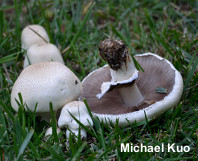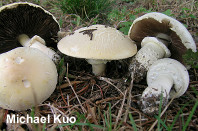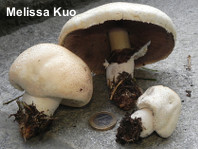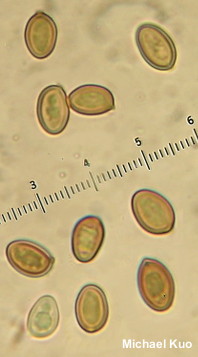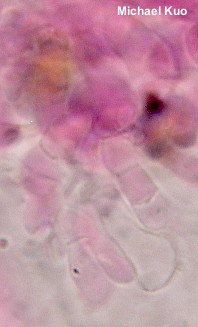| Major Groups > Gilled Mushrooms > Dark-Spored > Agaricus > Agaricus fissuratus |

|
Agaricus fissuratus [ Basidiomycota > Agaricales > Agaricaceae > Agaricus . . . ] by Michael Kuo Agaricus fissuratus is a fairly large species of Agaricus found in grassy areas. Its cap starts out whitish, but usually develops yellowish shades, and will often bruise yellow if rubbed. In old age the cap surface sometimes develops cracks and fissures (hence the species epithet). The stem features a prominent ring with a "cogwheeled" underside. The flesh will sometimes turn yellowish when sliced—and the odor of the flesh, while usually not strong, is sweet and reminiscent of almonds. In North America and in some European treatments Agaricus fissuratus has been called "Agaricus arvensis" by mycologists through the years, but according to Kerrigan (2016) we have been folding two species—Agaricus fissuratus and the true Agaricus arvensis—into one with this practice. Agaricus arvensis is whiter, often a little stockier, and features smaller spores. Calling the mushroom described and illustrated here Agaricus fissuratus "will represent an adjustment for North American mycologists," Kerrigan says. The common name "horse mushroom" was often applied to Agaricus arvensis in field guides. But when the scientific name for a common species is changed, should the common name be changed as well? If so, I think we should call Agaricus fissuratus the "Make Fun of the Foreigner Mushroom," since my first memorable experience with the species involves me attempting to back away from a grill in Finland, where my Finnish girlfriend's Finnish father had just finished igniting the coals with a Finnish match. I backed away fast, and stumbled over a patch of very large Agaricus fissuratus mushrooms. I landed flat on my American butt, with a little piece of mushroom on my face, and received a chorus of raucous laughter from my girlfriend's family. They had quite a few things to say about the sieniammattimies ("mushroom expert") and his expertise . . . Description: Ecology: Saprobic; growing alone, scattered, or gregariously in grassy places (lawns, fields, and so on); summer and fall (also winter and spring in warmer climates); probably widely distributed in North America; widely distributed in Europe. The illustrated and described collections are from Illinois and Italy. Cap: 5–13 cm; nearly round at first, often with a somewhat flattened center; later broadly convex or nearly flat; dry; often bald when young, but usually developing appressed fibrils and tiny fibrillose scales with age; whitish to yellowish, usually becoming yellowish overall; usually bruising yellow when rubbed repeatedly; the margin often with hanging partial veil remnants. Gills: Free from the stem; close or crowded; short-gills frequent; whitish at first, becoming grayish to grayish brown, and finally brown—without a pink stage; at first covered by a whitish to yellowish partial veil that features a "cogwheeled" surface. Stem: 5–10 cm long; 1.5–3 cm thick; equal above a slightly swollen (but not bulbous) base; more or less bald; whitish, becoming yellowish; usually bruising yellow; with a fairly persistent, large, whitish to yellowish ring that is often "cogwheeled" on the lower surface. Flesh: Firm; white throughout; not changing color when sliced, or yellowing slightly; flesh in stem base not yellowing. Odor and Taste: Odor reminiscent of almonds when young and fresh, becoming less distinctive; taste not distinctive. Dried Specimens: Cap and stem dull orangish yellow. Chemical Reactions: KOH yellow on cap surface. Spore Print: Dark brown. Microscopic Features: Spores 6–9 x 4–6 µm; ellipsoid, with a small apiculus; smooth; thick-walled; pale brown in KOH; inamyloid. Basidia 4-sterigmate. Cheilocystidia 20–30 x 4–8 µm; multiseptate, composed of subglobose elements and a subglobose to pyriform or clavate terminal cell; smooth; thin-walled; hyaline in KOH. Pleurocystidia not found. Pileipellis a cutis; elements 2.5–5 µm wide, smooth, hyaline to yellowish in KOH. REFERENCES: F. H. Møller, 1952. (Kauffman, 1918; Smith, Smith & Weber, 1979; Arora, 1986; Kerrigan, 1986; McKnight & McKnight, 1987; Phillips, 1991/2005; Lincoff, 1992; Calvo-Bado et al., 2000; Nauta, 2001; McNeil, 2006; Miller & Miller, 2006; Kuo, 2007; Kuo & Methven, 2014; Desjardin, Wood & Stevens, 2015; Evenson, 2015; Kerrigan, 2016; Siegel & Schwarz, 2016.) Herb. Kuo 09280605, 11121101, 10141409. This site contains no information about the edibility or toxicity of mushrooms. |
© MushroomExpert.Com |
|
Cite this page as: Kuo, M. (2017, November). Agaricus fissuratus. Retrieved from the MushroomExpert.Com Web site: http://www.mushroomexpert.com/agaricus_fissuratus.html |
